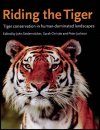Out of Print
Edited By: John Seidensticker, Sarah Christie and Peter Jackson
383 pages, 80 col plates, 28 b/w photos, 51 col illus, 51 tabs, col maps
![Riding the Tiger Riding the Tiger]()
Click to have a closer look
About this book
Related titles
About this book
Edited by three of the world's most eminent tiger conservationists, this readable, comprehensive and scientific account of the problems and possible solutions of tiger conservation is a major addition to the literature. Drawn from contributions to the Tigers 2000 conference (London Zoo, 1997) it ably demonstrates how habitat loss, conflicts between humans and wild tigers, and poaching for skins or body parts have caused a catastrophic decline in tiger numbers throughout their range. More critically, it outlines what can be done to rescue the situation. Well illustrated, it is accessible to the general reader as well as serious students of carnivore conservation and conservation biology.
Contents. Part 1: Introducing the tiger: 1. Ecology, behaviour and resilience of the tiger and its conservation needs; 2. Tiger distribution, phenotypic variation and conservation issues; 3. Subspecies of tigers; 4. The tiger in human consciousness; Part 2: Tiger Ecology: Understanding and Encouraging Landscape Patterns and Conditions Where Tigers Can Persist: 5. Population dynamics of the Amur tiger in Sikhore-Alin; 6. Hierarchical spatial analysis of the Amur tiger relationships to habitat and prey; 7. Prey depletion as a critical determinant of tiger population viability; 8. Long-term monitoring of Indian tigers; 9. Tigers in Panna; 10. Last of the Indonesian Tigers: A cause of optimism; 11. The status of the Indochinese tiger: Separating fact from fiction; 12. Mapping the metapopulation structure of Thailand's tigers; 13. Metapopulation structure of tigers in Nepal; Part 3: Approaches to tiger conservation: A - Linking in situ and ex situ tiger conservation; 14. Effective tiger conservation requires co-operation; B - The trade in tiger parts and what to do about it 15. The beginning of the end of tigers in trade; 16. Roaring back: Anti-poaching operations in the Russian Far East and the comeback of the Amur tiger; 17. Tiger anti-trade and antipoaching strategies for the Indian sub-continent C - People, tiger habitat availability, and linkages for the tiger's future: 18. Where can tigers live in the future? A framework for identifying high priority areas for the conservation of tigers in the wild; 19. A habitat protection plan for the Amur tiger; 20. The tragedy of the Indian tiger: Starting from scratch; 21. Reconciling the needs of conservation and local communities: The Global Environment Facility approach to tiger conservation; 22. Tigers as neighbours: A report on efforts to promote local guardianship of endangered species in lowland Nepal; Epilogue: Vision and process in securing a future for wild tigers.
`Nicely illustrated with colour maps and pictures with text that is approachable and understandable by the lay reader.' Bulletin of the British Ecological Society
Customer Reviews
Out of Print
Edited By: John Seidensticker, Sarah Christie and Peter Jackson
383 pages, 80 col plates, 28 b/w photos, 51 col illus, 51 tabs, col maps



































